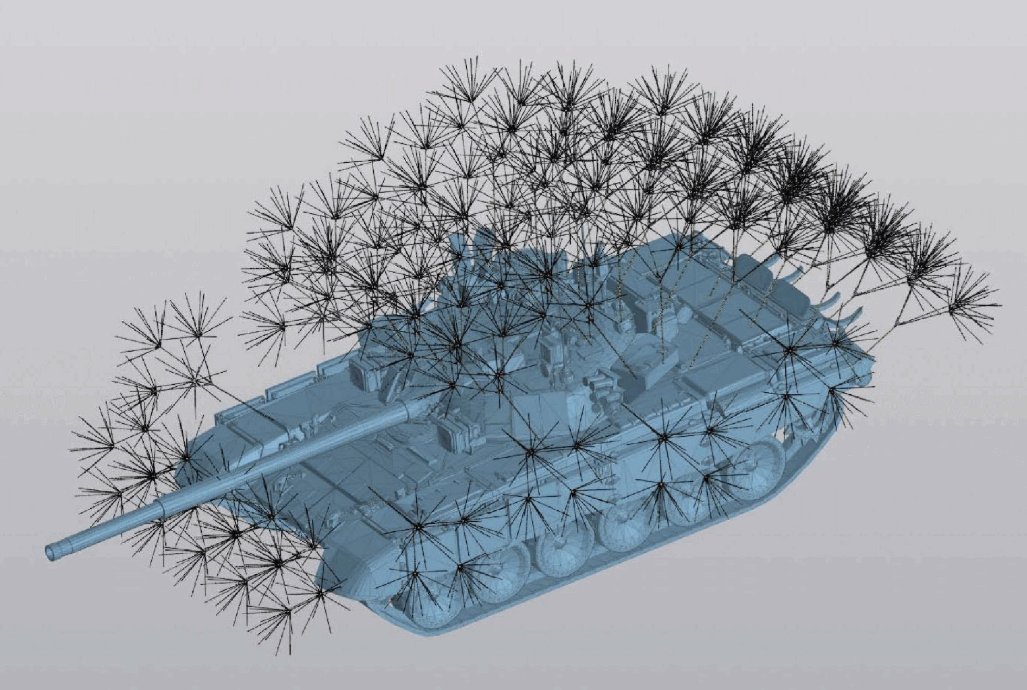- Adding branching metal florets to a tank could protect it from first-person-view drones
- This "dandelion tank" is still just a concept, but potentially a sound one
- The Russians are introducing anti-drone innovations at an accelerating pace
- The add-on armor increases the cost of Ukrainian drone operations
Russia's anti-drone innovations are coming faster and faster. The next might be a so-called "dandelion tank" with branching metal florets that can trigger enemy first-person-view drones before they strike the vehicle's hull.
If past generations of Russian anti-drone defenses are any indication, the dandelion defense might actually work. Even if it is very, very ugly.
How Russia's dandelion tank defense works
The dandelion tank design recently appeared in a Russian patent application noted by observer AndreiBtvt. "The passive protection device consists of sets of rods made of flexible material, interconnected into a tree-like (branching) structure that forms a voluminous protective barrier," AndreiBtvt wrote.
The key to the new anti-drone design is its layers, AndreiBtvt explained. "The tree-like structure comprises multiple tiers. Each tier contains flexible rods of varying lengths and cross-sections. The upper tiers are made of thin-section rods, while the lower tiers consist of thicker-section rods."
"The number of rods increases from the bottom tier to the top," AndreiBtvt added. "The rods are connected to each other using easily detachable coupling elements. The flexible rods are made of fiberglass rebar of various diameters. The coupling elements are made of shaped sheet metal or impact-resistant plastic."
"Between the upper tiers of the tree-like structures, a fine-mesh net made of high-strength synthetic material (e.g. Kevlar-type) is stretched."
From cope cages to dandelions: 3 years of evolution
No dandelion tanks have appeared along the 1,100-km front line of Russia's 45-month wider war on Ukraine. Yet. But they may show up soon, marking the next step in vehicular evolution.
In 2022, there were "cope cages"—encasements with metal slats or mesh that, installed atop or around an armored vehicle's turret, might block incoming FPVs.
A year later, the "turtle tanks" first appeared. Now entire vehicles were wrapped in drone-blocking metal shells. In 2024, the Russians added hundreds of thick metal spines to some cope cages or turtle tanks, betting—correctly, it turned out—that the resulting "porcupine tanks" would absorb even more drones.
This year, the spines became thinner metal "hairs" made of unwound aluminum cable. The "hedgehog tanks" wearing potentially tens of thousands of these hairs are the best-protected vehicles of Russia's 45-month wider war on Ukraine.
Some of these up-armored vehicles—the turtles, porcupines and hedgehogs, in particular—can eat dozens of FPV drones before finally succumbing. That toughness increases the chance a Russian assault group might make it through the drone-patrolled no-man's-land and drop off infantry to seize new positions.
But Ukrainian drones and tactics improve alongside Russian defenses, so the Russians have been thinking ahead to the next innovation. The dandelion tank may be a leading candidate for front-line use.
Evolution of Russian drone protection on tanks:
- 2022: Cope cages with metal slats and mesh
- 2023: Turtle tanks with full metal shells
- 2024: Porcupine tanks with thick metal spines
- 2025: Hedgehog tanks with tens of thousands of thin aluminum hairs
- Patent filed: Dandelion tanks with branching florets
Trending Now
Tough but not invulnerable
The turtles, porcupines, hedgehogs aren't invulnerable, but they have raised the cost of Ukrainian drone operations. Dandelions could further raise the cost.
"If a tank is spotted with cages and a jammer, it takes at least double or triple the usual number—six to eight drones—to disable it" compared to a standard assault vehicle, one Ukrainian drone operator told Ukrainian-American war correspondent David Kirichenko. "We used to laugh at their cages, but now we use them, too."
Examples abound of turtle and porcupine tanks shrugging off dozens of drone strikes before finally succumbing to a drone, mine or artillery. One heavily up-armored Russian turtle tank ate around 25 Ukrainian mines and first-person-view drones before the 26th munition—a drone—finally disabled it during an assault toward the city of Siversk in eastern Ukraine in late October.
Ukraine produces a lot of tiny drones: probably hundreds of thousands per month, millions per year.
But demand is enormous. A Ukrainian battalion might have 300 small drones to fling at any one Russian assault group. If the Russians exhaust the Ukrainians' drone supply before losing their last vehicle, they may be able to land a few infantry in a new position.
"For those mocking armored vehicles and specially turtle tanks and thinking drones are a wunderwaffe that have rendered armor obsolete, take a look at the sheer amount of FPVs that are required to destroy a well up-armored tank," analyst Jompy wrote.
"It's not about how many dollars a tanks costs versus a drone," Jompy added. "It's about how many targets drone-intensive defenses can take out before being overwhelmed." The dandelion tanks could have the toughest defenses yet.



